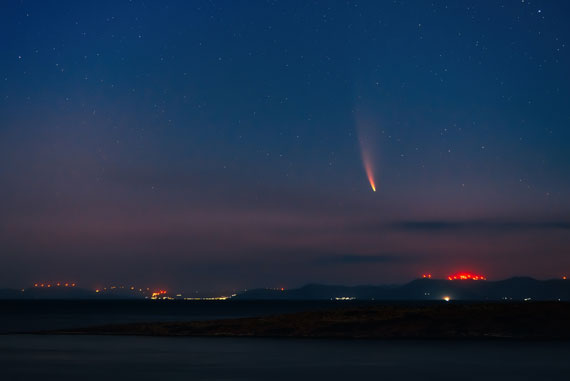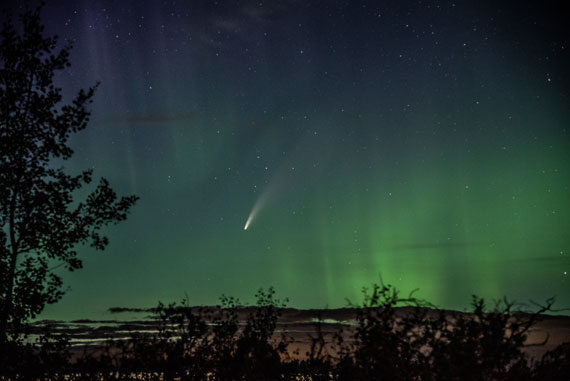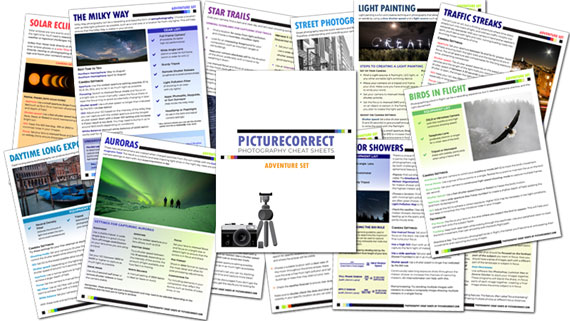Capturing the ephemeral beauty of a comet as it dances across the night sky is an experience that can leave an indelible mark on a photographer’s heart. These celestial wonders, with their blazing cores and trailing tails, offer a unique opportunity to photographers. If you’ve ever dreamt of capturing this spectacle, you’re in for an adventure.
The next comet that may be visible from Earth is C/2023 A3 (Tsuchinshan-ATLAS). Identified at the dawn of 2023, it’s predicted to brighten to a magnitude of -4.0 by October 2024. On October 10, 2024, this comet will draw nearest to our Sun. For optimal viewing, those in the northern hemisphere should gaze southwest shortly after the day’s end. As days progress post its solar approach, it will ascend further southward, becoming a spectacle for the unaided eye.
Also just a quick reminder, for a “Comet Camera Settings” cheat sheet and more, you may want to check out this launch sale ending soon on the new Photography Adventure Cheat Sheets at 80% Off

Photo captured by Tasos Mansour; 50mm, f/2.2, 5s, ISO 800
When a comet swings close to Earth, it often becomes a headline-grabbing event. However, a comet’s appearance in the night sky requires preparation and a bit of knowledge to photograph effectively. Here’s how to do it:
Research is Key
Before you can photograph a comet, you need to know when and where to look. There are many online astronomical calendars and apps that will inform you about upcoming celestial events, including comets. Research the date, time, and position in the sky to ensure you don’t miss out.
Find Your Perfect Spot
First and foremost, scout for a location that’s pitch dark. Comets, especially their tails, can be faint, and the glow of city lights can easily drown them out. National parks, countryside locations, or high elevations often offer the best views.
Essential Gear for Comet Photography
- Lens: If you want to capture the broader context with some foreground, a lens around 70mm is excellent. However, for a closer and more detailed shot of the comet, opt for lenses between 100-400mm or even more.
- Tripod: Stability is key. A robust tripod ensures that your camera remains steady during long exposures, preventing blurry shots.
- Remote Shutter Release: This tool allows you to trigger your camera without touching it, eliminating potential shake. If you don’t have one, the camera’s self-timer can be a good alternative.
Setting Up Your Camera
- Focusing: Switch your camera to manual focus. Using the live view function, magnify the image by 10x and manually adjust the focus until the edges of the comet and stars appear sharp.
- Aperture: Opt for the widest aperture your lens allows (e.g., f/2.8 or f/4). This setting lets in the maximum amount of light, which is crucial when photographing dim subjects like comets.
- Shutter Speed: The optimal exposure time can vary depending on the comet’s brightness and ambient light. Begin with an exposure of a few seconds and adjust accordingly. Remember, to avoid star trails due to Earth’s rotation, use the 500 rule: divide 500 by your lens’s focal length to get the maximum exposure time in seconds.
- ISO: Start with a moderate ISO setting around 500. Depending on your results and available light, you may need to increase this. While higher ISO values capture more light, they can also introduce noise. With modern cameras, however, ISO values of 1600-6400 often still produce relatively clean images.

Photo captured by Julian Winfield; 70mm, f/4, 5s, ISO 2000
Enhancing Your Comet Shots
- Image Stacking: This technique involves taking multiple shots of the comet and stacking them in post-processing software. Stacking can help reduce noise, improve detail, and enhance the visibility of faint comet tails.
Embrace Patience
Like many astrophotography endeavors, capturing the perfect shot of a comet requires patience. Factors like changing weather conditions, comet brightness, or even unexpected light pollution sources can pose challenges. However, persistence is often rewarded with awe-inspiring images.
Photographing a comet is a fusion of preparation, the right equipment, and a dash of serendipity. With these guidelines in hand, you’re well-equipped to capture these fleeting celestial visitors in all their glory. Clear skies and happy shooting!
For Further Training:
Have you ever wanted to photograph an amazing once-in-a-lifetime moment but missed the shot? This new set of Photography Adventure Cheat Sheets have you covered. With camera settings and critical information on the most challenging photography situations, you’ll never be unprepared again. They are currently 80% off for the launch sale which ends soon if you want to check them out.
The perfect companion for any photographer. Print one out whenever you need it. Whether you’re going on vacation or seeking out a specific photography adventure, these cheat sheets can provide you with the knowledge and inspiration you need to create your best work yet.
Launch sale ending soon: The Photography Adventure Cheat Sheets at 80% Off
- - - - - - - - - - - - - - - - - - - - - - - - - - - - - - - - - - - - - - - - - - - - - - - - - - - - - - - - - - - - - - - - - - - - - - - - - -
Did you appreciate this newsletter? Please help us keep it going by Joining Our Patreon Supporters
What are your thoughts on this article? Join the discussion on our Facebook Page
PictureCorrect subscribers can also learn more today with our #1 bestseller: The Photography Tutorial eBook
- - - - - - - - - - - - - - - - - - - - - - - - - - - - - - - - - - - - - - - - - - - - - - - - - - - - - - - - - - - - - - - - - - - - - - - - - -
The post Comet Photography Tips appeared first on PictureCorrect.
from PictureCorrect https://ift.tt/XLDxjKk
via IFTTT







0 kommenttia:
Lähetä kommentti